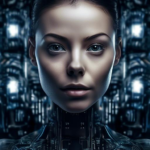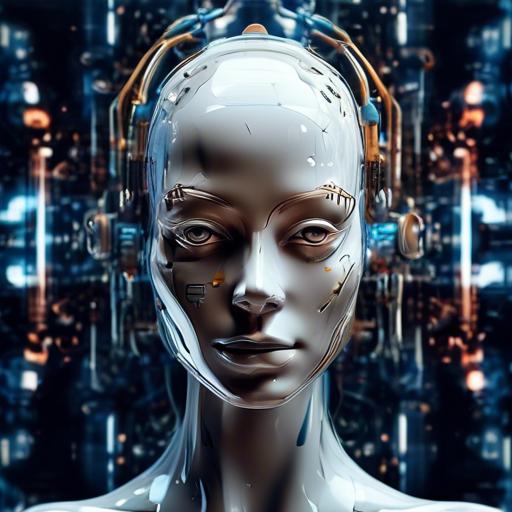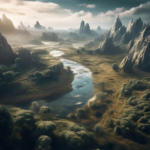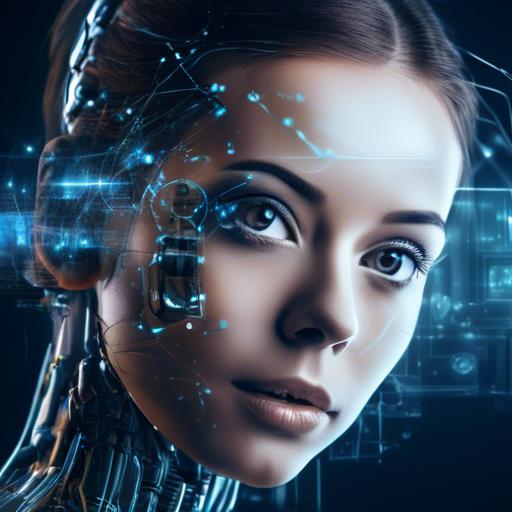Picture a world where your imagination knows no bounds, where the landscapes of your dreams, the faces of characters you’ve only seen in your mind’s eye, and the intricate designs that dance through your thoughts can come to life with the click of a button. Welcome to the enchanting realm of AI Image Generation, a technological wonderland where creativity and innovation intersect. This burgeoning field is revolutionizing the way we create, perceive, and interact with images, opening doors to artistic possibilities previously confined to the realms of fantasy. In this article, we’ll journey through the key trends and innovations that are shaping this dynamic landscape, exploring how artificial intelligence is not only transforming the artistic process but also empowering creators of all kinds to turn their visionary ideas into vivid reality. So, buckle up and let your imagination soar as we dive into the captivating world of AI Image Generation.
Table of Contents
- The Dawn of Imagination: AI’s Impact on Image Generation
- Revolutionizing Creativity: Top Trends in AI-Driven Art
- Innovative Algorithms: Pushing the Boundaries of Visual Content
- From Pixels to Masterpieces: AI Techniques Transforming Imagery
- Harnessing AI for Brand Visual Identity: Best Practices
- Ethical Considerations: Navigating AI Art in a Digital Age
- Empowering Artists and Designers: How to Leverage AI Tools
- Future Outlook
The Dawn of Imagination: AI’s Impact on Image Generation
In the realm of digital artistry, Artificial Intelligence (AI) has become a pivotal force, transforming the ways we conceive and create images. The era of painstakingly detailed handcrafting has now converged with the precision and speed of automated systems, cultivating a fertile ground for innovation and creative freedom.
AI-driven image generation tools are not only enhancing the efficiency of professional designers and artists but also democratizing art creation for novices. Various platforms are now harnessing the power of **neural networks** and **deep learning algorithms** to instantaneously convert text prompts into vivid, intricate visuals. This revolution is not just limited to 2D illustrations; AI is influencing **3D modeling**, **virtual environments**, and even **interactive experiences**. Just imagine inputting a simple description and receiving a fully rendered fantasy scene or a photorealistic portrait!
- Creativity Augmentation: AI assists creatives in experimenting with styles and techniques they may have not explored otherwise.
- Accessibility: Even those without extensive artistic training can generate professional-quality images.
- Efficiency: Reduces the time required for creating complex visuals.
Moreover, AI’s impact on image generation extends beyond convenience and quality. It paves the way for new art forms and visual experiences. For instance, AI can simulate historical art styles or invent completely new ones that never existed, offering a compelling blend of the old and the novel. Here’s a quick look at a few dominant trends in AI image generation:
| Trend | Description |
|---|---|
| Style Transfer | Applying the style of one image to another seamlessly. |
| Generative Adversarial Networks (GANs) | Creating highly realistic images from scratch. |
| Text-to-Image Synthesis | Generating images based solely on textual descriptions. |
From pushing the boundaries of what’s creatively possible to making high-quality visual content accessible to everyone, AI is irrevocably altering the landscape of image generation. As these intelligent systems continue to evolve and learn, the synergy between human creativity and machine precision will no doubt bring forth even more groundbreaking innovations.
Revolutionizing Creativity: Top Trends in AI-Driven Art
In recent years, AI-driven art has undergone seismic transformations, pushing the boundaries of creativity in ways that were once unimaginable. This surge of innovation has led to several compelling trends, altering how we perceive and create art.
One prominent trend is the **collaborative integration of AI and human creativity**. Artists are no longer merely relying on their personal skills and intuition; they are partnering with advanced algorithms to co-create masterpieces. These collaborations help to unlock new forms of expression and expand artistic boundaries. Leveraging **Generative Adversarial Networks (GANs)**, artists can generate unique textures, patterns, and even complex landscapes that add depth and dimension to their work.
Another fascinating development is the move towards **personalized art experiences**. AI algorithms are becoming proficient in curating bespoke art tailored to individual preferences. Based on user interaction data, AI can analyze artistic styles, colors, and themes that resonate most with a particular viewer. Such enhancements are making art more accessible and personalized, fostering deeper connections between art and audience.
The democratization of creativity is also a noteworthy trend. AI-generated art platforms and tools are making it easier for people without traditional art training to produce professional-quality artwork. Platforms like DeepArt and ArtBreeder are empowering a new generation of **digital artists**, allowing anyone with a computer and an internet connection to embark on creative journeys. By lowering the barriers to entry, these platforms are diversifying the art community and encouraging innovation from every corner of society.
The impact of AI on the art market is also profound. AI technologies are improving the way art is bought and sold, introducing smart algorithms for art valuation and authenticity verification. This is helping to foster trust and transparency in an industry that has long been criticized for its opaqueness. **Blockchain technology** is often integrated with AI to create verifiable records for digital artworks, ensuring provenance and protecting intellectual property rights.
Here’s a quick overview of some key innovations shaping AI-driven art:
| Innovation | Impact |
|---|---|
| Generative Adversarial Networks (GANs) | Enhanced creativity and novel art forms |
| Personalized Art Curation | Tailored art experiences |
| Artificial Intelligence Platforms | Democratization of art creation |
| AI and Blockchain Integration | Improved transparency and trust in the art market |
Innovative Algorithms: Pushing the Boundaries of Visual Content
In a world where visual content is continuously evolving, innovative algorithms stand at the forefront, revolutionizing how images are generated and perceived. These advanced technologies are pushing the limits of creativity, enabling the creation of stunning visuals with unprecedented ease and precision. Let’s dive into the cutting-edge algorithms that are shaping the future of AI image generation.
**Generative Adversarial Networks (GANs)** have taken the lead in producing highly realistic images. By pitting two neural networks against each other – one generating images and the other evaluating them – GANs iteratively improve, creating visuals that are often indistinguishable from real photos. Their applications range from art generation to detailed textures in video games, offering a vast array of creative opportunities.
- StyleGAN: An advanced version of GANs, capable of producing high-resolution, highly detailed images.
- CycleGAN: Excels in unpaired image-to-image translation, such as turning summer landscapes into winter scenes.
| Algorithm | Key Feature | Use Case |
|---|---|---|
| StyleGAN | High-Resolution Output | Art, Photography |
| CycleGAN | Unpaired Image Translation | Season Transformation |
Another breakthrough lies in the realm of **Neural Style Transfer** (NST), which merges the content of one image with the style of another. This method unleashes new artistic possibilities, enabling the generation of visually compelling content by blending various artistic styles with real-world subjects. Imagine taking a modern photograph and transforming it to reflect the charm of a Van Gogh painting.
**Text-to-Image Synthesis** algorithms have added a new dimension by converting descriptive text into vivid images. This advancement enables users to generate visuals simply by detailing what they imagine, bringing an abstract concept to life. OpenAI’s DALL-E is a prime example, creating imaginative and sometimes surreal images based on textual descriptions.
- DALL-E 2: Improved version of DALL-E, providing higher quality and more accurate image synthesis.
- BigGAN: Scales up GAN capability to produce more diverse and refined visuals.
The combination of these groundbreaking algorithms marks an era where the boundary between imagination and reality blurs, empowering artists, designers, and creators to explore new horizons. The infusion of AI into visual content generation not only enhances efficiency but also sparks endless creative potential.
From Pixels to Masterpieces: AI Techniques Transforming Imagery
At the core of transforming simple pixels into breathtaking artworks, **deep learning algorithms** and **neural networks** play pivotal roles. These advanced techniques empower machines to understand and recreate stunning visuals, often surpassing human capability in terms of speed and sometimes even creativity. With the aid of **Generative Adversarial Networks (GANs)**, AI has the remarkable ability to generate highly realistic and original images from scratch, bringing an artist’s imagination to life faster than ever before.
Modern AI techniques have introduced several **key innovations**:
- Neural Style Transfer: This technique allows AI to apply the stylistic elements of one image (e.g., Van Gogh’s Starry Night) to another, blending content and style in unparalleled ways.
- Super Resolution: With AI’s ability to upscale lower resolution images to higher resolutions while preserving details, even the smallest pixelated photo can become a crisp, clear masterpiece.
- Image Inpainting: This removes unwanted objects or repairs damaged areas in photos by filling in gaps with plausible content drawn from its extensive data knowledge, akin to a digital restoration artist.
- Semantic Segmentation: AI can break down images and segment different objects within them for more efficient editing, enhancing visual communications and digital art.
Incorporating AI into the world of imagery isn’t just limited to generation; it’s also about **enhancing and editing** images seamlessly. Artists and designers leverage AI tools to refine their work, making colors pop, adjusting layouts, or even imagining alternative renditions. The collaboration between human creativity and artificial intelligence opens a new horizon of artistic possibilities.
| AI Technique | Benefits for Artists |
|---|---|
| Neural Style Transfer | Merges styles to create unique visuals |
| Super Resolution | Enhances image quality effortlessly |
| Image Inpainting | Repairs and refines images accurately |
| Semantic Segmentation | Improves targeted editing processes |
The future of imagery is brimming with exciting possibilities, thanks to the continuous advancements in **AI technology**. As AI continues to evolve, it will further democratize the art-making process, allowing aspiring artists, seasoned professionals, and even casual enthusiasts to create and transform images in ways previously unimaginable. This artistic revolution, driven by artificial intelligence, promises to keep inspiring creators and pushing the boundaries of what’s possible in art and design.
Harnessing AI for Brand Visual Identity: Best Practices
Creating a strong visual identity is crucial for any brand, and with the rise of AI technology, achieving this goal has become more streamlined than ever. AI image generation not only saves time but also offers innovative ways to unleash creativity. Here are some best practices to make the most of AI for defining your brand’s visual presence.
- Leverage Customization: One size doesn’t fit all. AI tools can generate a wide range of images tailored to specific brand guidelines. Utilize these customization options to reflect unique brand colors, typographies, and themes.
- Use Diverse Datasets: To avoid generic outputs, feed the AI with diverse datasets. This helps in creating unique and varied visuals that stand out and resonate with a broader audience.
- Iterative Feedback: AI models learn and improve based on feedback. Regularly review and provide input on generated images to refine the visual identity progressively.
| Best Practice | Description |
|---|---|
| Leverage Customization | Create tailored visuals that align with brand guidelines. |
| Use Diverse Datasets | Input varied data to enhance image uniqueness. |
| Iterative Feedback | Continuously improve visuals with regular feedback. |
AI-generated images can be seamlessly integrated with existing brand assets. This not only augments consistency but also enhances brand recognition. Consistent style and theme integration across all brand touchpoints—social media, website, print media—creates a cohesive visual story that resonates stronger with the audience.
stay ahead of the curve by experimenting with emerging AI trends. New algorithms and models continually evolve in the AI field, offering more sophisticated and refined outcomes. By staying updated, you can incorporate cutting-edge technology to make your brand’s visuals not just appealing but also avant-garde.
Ethical Considerations: Navigating AI Art in a Digital Age
As AI-driven tools revolutionize the art scene, a host of ethical dilemmas surfaces, challenging conventional norms and pushing us to rethink creativity and ownership. **Artists, technologists, and consumers** alike must grapple with questions about the authenticity and originality of AI-generated imagery.
- **Intellectual Property**: Who owns an artwork created by an algorithm?
- **Artist Attribution**: Should AI creations be credited to machines, their programmers, or both?
- **Bias and Fairness**: How do biases in training data impact the diversity and representation in AI art?
In the realm of intellectual property, existing laws often fall short. Traditional copyright systems are ill-equipped to address the nuances of art birthed by AI. This raises the necessity for **new legal frameworks** that can better delineate the ownership of such digital assets. For instance, when an artificially intelligent system generates a piece based on pre-existing data sets, the question of who holds the rights becomes muddled.
| Scenario | Ownership Consideration |
|---|---|
| AI generates art autonomously | Creator of AI algorithm |
| Artist manipulates AI outputs | Hybrid ownership model |
Bias in AI-generated art is another pressing concern. **Training data** often embeds societal prejudices, which may inadvertently propagate through machine-generated media. Prioritizing **diversity in datasets** and implementing rigorous checks can mitigate such issues, fostering an environment where AI art reflects the multifaceted nature of human culture.
Ultimately, understanding these ethical considerations is not just about addressing immediate challenges but also about forging a path towards a responsible and sustainable future for AI in art. By embracing these complexities and navigating them thoughtfully, we can harness the potential of AI to enrich our creative landscapes while maintaining respect for the ethical principles that underpin our society.
Empowering Artists and Designers: How to Leverage AI Tools
Artificial Intelligence is not just a futuristic concept; it’s a powerful ally in the toolkit of today’s artists and designers. AI tools enable creators to push the boundaries of their imagination, transforming ideas into stunning visuals with unprecedented swiftness and accuracy.
Here’s how artists and designers can harness the power of AI to elevate their craft:
- Enhance Creativity: AI tools can suggest styles, color schemes, and compositions, offering a fresh perspective that can inspire new artistic directions.
- Save Time: Creating detailed images or graphic designs manually can be time-consuming. AI accelerates this process, delivering high-quality outputs that usually take hours to produce in just minutes.
- Experimentation: Artists can rapidly prototype multiple versions of their work, tweaking parameters and seeing instant results without the need for intensive retouching.
To illustrate the impact of AI on creative processes, consider the following table showcasing some popular AI tools and their key features:
| AI Tool | Main Feature | Use Case |
|---|---|---|
| DeepArt.io | Style Transfer | Transforming photographs into artworks |
| Runway ML | Real-time image generation | Interactive art installations |
| DALL·E | Text-to-image synthesis | Generating visual content from text descriptions |
Embracing AI tools allows artists and designers to engage in more ambitious projects, collaborate more effectively, and realize their visions with greater fidelity. While preserving the unique human touch, AI-powered creativity sets new standards and creates opportunities that were once beyond reach.
Future Outlook
AI image generation has opened up a world of possibilities for creativity and innovation. As we continue to see advancements in this field, it is clear that the future holds exciting opportunities for artists, designers, and creators alike. From realistic landscapes to abstract designs, AI is reshaping the way we approach visual content creation. So, let’s embrace these key trends and innovations and look forward to a future where the only limit is our imagination. The possibilities are truly endless. Let’s create together!
































